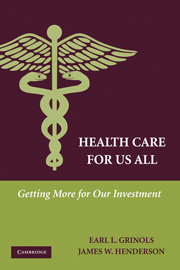Book contents
- Frontmatter
- Contents
- List of Tables
- List of Figures
- Preface
- Acknowledgments
- Executive Summary of the Targeted Intervention Plan
- PART I GOALS AND WORKING PRINCIPLES
- PART II BACKGROUND ECONOMICS AND ETHICS
- PART III APPLICATION
- PART IV PROTECTIVE MEASURES
- A Top Ten Goals for the American Health Care System
- B Badly Done Insurance Programs Can be Worse Than No Insurance
- C Incentive Symmetry and Intervention Principle
- D Plan Workability
- E Market Power Response to Insurance
- Glossary and Definitions
- References
- Index
C - Incentive Symmetry and Intervention Principle
Published online by Cambridge University Press: 05 June 2012
- Frontmatter
- Contents
- List of Tables
- List of Figures
- Preface
- Acknowledgments
- Executive Summary of the Targeted Intervention Plan
- PART I GOALS AND WORKING PRINCIPLES
- PART II BACKGROUND ECONOMICS AND ETHICS
- PART III APPLICATION
- PART IV PROTECTIVE MEASURES
- A Top Ten Goals for the American Health Care System
- B Badly Done Insurance Programs Can be Worse Than No Insurance
- C Incentive Symmetry and Intervention Principle
- D Plan Workability
- E Market Power Response to Insurance
- Glossary and Definitions
- References
- Index
Summary
The decision-making units of an economy consist of firms, households, and government. If an economic equilibrium does not achieve a desired outcome, then an outside influence in the form of changed incentives is needed to move the equilibrium to accomplish the outcome. In most cases, there are different ways to do this, implying that there is a best way. “Best” means accomplishing the altered outcome in a fashion with highest utility for the people that make up the economy, so why not do it in the best (i.e., most efficient) way? Otherwise, you are saying that the same objective could be accomplished, raising the well-being of one or more individuals without harming others, but you are choosing not to do so. This is the basic meaning of efficiency. Rather than merely “order people about,” economic theory has something to say about the way to intervene in an economy using the tax system to create incentives that encourage people to take the coordinated steps they need to take. Tax tools must be used in the right way for these methods to work, but, then, that is the message of this book. This appendix demonstrates in more detail for a technical audience two of the principles that lead us to conclude that there is a virtually unique way to accomplish national health care objectives best.
We first demonstrate incentive symmetry. Firms, consumers, and government might face different prices according to which taxes and circumstances apply to each. Given world prices, if all prices for producers were multiplied by the same non-negative number, producer choices would be unchanged.
- Type
- Chapter
- Information
- Health Care for Us AllGetting More for Our Investment, pp. 231 - 236Publisher: Cambridge University PressPrint publication year: 2009



